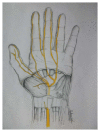A handy review of carpal tunnel syndrome: From anatomy to diagnosis and treatment
- PMID: 24976931
- PMCID: PMC4072815
- DOI: 10.4329/wjr.v6.i6.284
A handy review of carpal tunnel syndrome: From anatomy to diagnosis and treatment
Abstract
Carpal tunnel syndrome (CTS) is the most commonly diagnosed disabling condition of the upper extremities. It is the most commonly known and prevalent type of peripheral entrapment neuropathy that accounts for about 90% of all entrapment neuropathies. This review aims to provide an outline of CTS by considering anatomy, pathophysiology, clinical manifestation, diagnostic modalities and management of this common condition, with an emphasis on the diagnostic imaging evaluation.
Keywords: Anatomy; Carpal tunnel syndrome; Computed tomography; Diagnosis; Magnetic resonance imaging; Nerve conduction study; Treatment; Ultrasonography.
Figures








References
-
- Katz JN, Simmons BP. Clinical practice. Carpal tunnel syndrome. N Engl J Med. 2002;346:1807–1812. - PubMed
-
- Mashoof AA, Levy HJ, Soifer TB, Miller-Soifer F, Bryk E, Vigorita V. Neural anatomy of the transverse carpal ligament. Clin Orthop Relat Res. 2001;(386):218–221. - PubMed
-
- Uchiyama S, Itsubo T, Nakamura K, Kato H, Yasutomi T, Momose T. Current concepts of carpal tunnel syndrome: pathophysiology, treatment, and evaluation. J Orthop Sci. 2010;15:1–13. - PubMed
Publication types
LinkOut - more resources
Full Text Sources
Other Literature Sources
Medical
Research Materials

